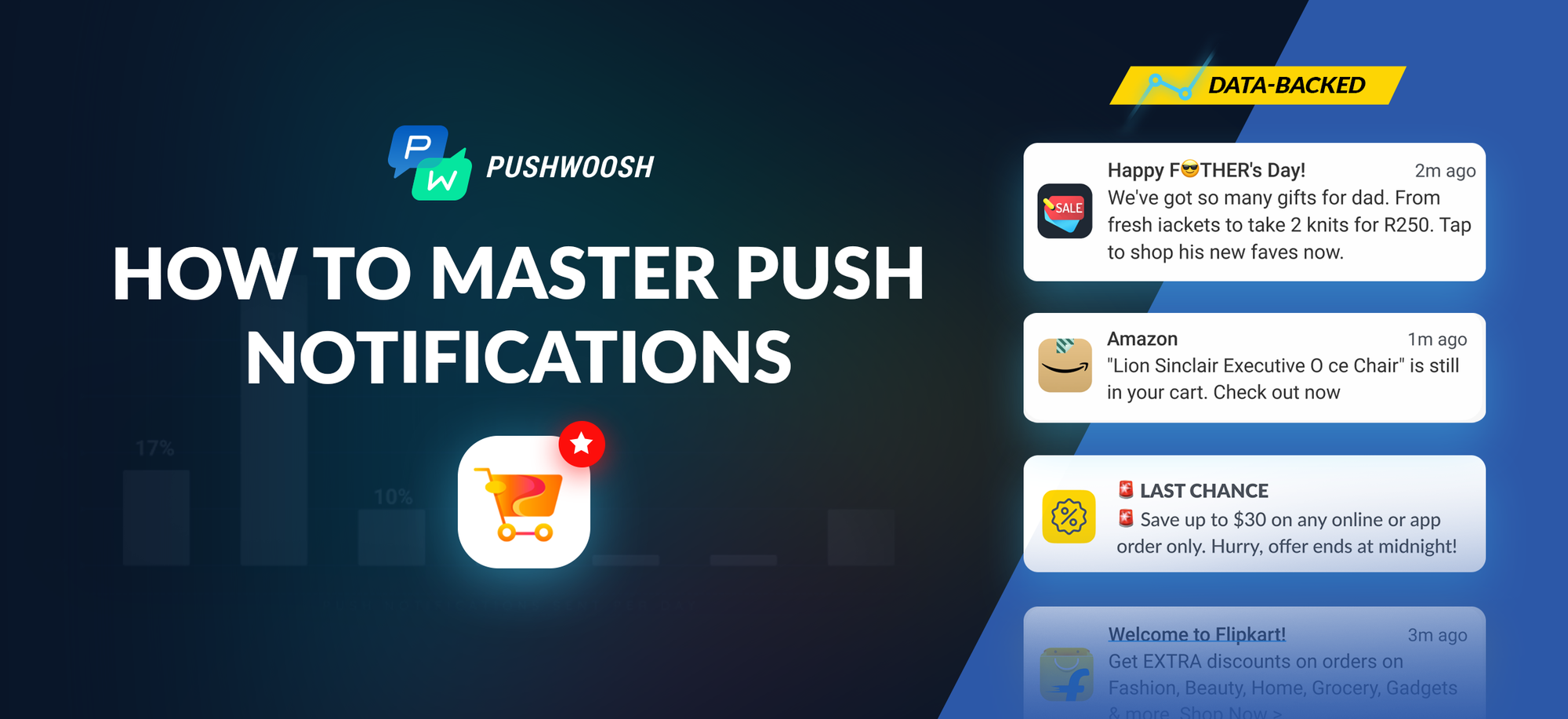The coronavirus pandemic has accelerated digital transformation, and significant changes in consumer behavior have come as a result. The boom of online shopping has forced brands to rapidly change their marketing strategies, especially on mobile. The digital growth is expected to continue: eMarketer predicts global retail m-commerce sales to make up 69.9% of total retail e-commerce sales by 2024.
Pushwoosh and Net Solutions have gathered and analyzed the e-commerce industry data for the entire 2021 in the mobile landscape — and came up with the best push notifications practices for e-commerce businesses. We set the goal to identify current trends in mobile app marketing and determine the crucial factors that companies should take into account when building their communication strategies in the new normal.
Mobile Push Notifications: Best Practices in E-Commerce Perspective
Behavior-Based Communications
Push Notification Frequency
Push Notification CTRs
Visual Elements in Push Notifications
Emotional Triggers in Push Notifications
Push Notification Strategy for E-Commerce Done Right

Mobile Push Notifications: Best Practices in the E-Commerce Perspective
As an e-commerce business, you are most likely to aim at attracting new customers and growing sales in a highly competitive and rapidly changing world. Luckily, mobile push notifications are here to help you connect with your customers effectively: engage, convert, and retain them.
These are just some of the most common use cases for shopping apps:
Engage new app users and convert them into paying customers, offering a welcome promo code or free delivery for the first purchase — these gestures also contribute to customer loyalty.

Inform customers of the price drop and induce FOMO in your users by sending out messages with a sense of urgency, e.g. ‘Hurry up and get your headphones before stocks run out!’

Increase your average order value (AOV) by cross-selling relevant products typically bought together, and take advantage of holidays and celebrations throughout the year: invite customers to purchase gifts for friends and family.

Behavior-Based Communications: Best Practices for E-Commerce Apps
Automated behavior-based push notifications allow digital-first e-commerces to accompany their clients along the customer journey at the moments that matter. Therefore, such push notifications contribute to a smooth customer experience and maximize customer lifetime value.
Here are some great examples:
Update customers on the items left in their cart or wishlist or relevant products being back in stock. Reduce cart abandonment rates: identify your most valuable customers and motivate them to complete the purchase by offering a personal discount or product recommendations.

Inform users of their order status updates and gather product reviews and customer feedback after the order delivery.

Alert your app users of special offers when they are near your physical store and suggest quick alternatives to the out‑of‑stock items.

That’s just a small part of what you can do using behavior-based automated push notifications. It’s all about testing!
In addition to these e-commerce best practices, diversify your messages with FOMO, discounts, price anchoring, and bundling incentives.
E-Commerce App Push Notification Frequency: Don’t Be Perceived As Annoying
Push notifications are one of the most effective messaging tools: their open rate is twice higher than that of emails. With push notifications, marketers can bring users back to the app, engage and retain them.
In fact, Pushwoosh customers have proved that push notifications have an evident positive impact on such metrics as App Opens and the number of Active Users.
However, many users see push notifications as intrusive and annoying. Wonder how to make your pushes be seen in a more positive light? Take a smart approach to push notifications including:
- Relevant and timely messaging
- Personalization
- Providing value to a customer
- Frequency capping
- Repeating messages with a scheduled launch
According to our data, the majority of e-commerce apps have adopted the ‘less is more’ rule: to avoid spamming, they send only 1–2 push notifications per day.

How to Achieve Better Push Notification CTRs
Stick to the well-known 3R rule: Relevant Messages at the Right Time to the Right Audience.
To achieve the maximum impact from this communication channel, make sure that your push notifications are based on user preferences and triggered by their behavior. Segmentation on behavioral attributes (added to cart, visited the catalog section, viewed a particular item, etc.) and preferences (a specific brand of product, collection, etc.) increase the relevance of distributed notifications and their engagement rates.
Continuous Testing and Optimization
We recommend you conduct numerous experiments with content, segmentation, volume, and sending time of your messages to find out when your users are most receptive.

Experiments with Push Notification Copy
Use emojis and dynamic content; add the sense of urgency, scarcity, curiosity… Make your reader feel special!

Rich Media Push Notifications and Gamification
Visual and interactive content like images, GIFs, and videos are so much relevant and effective in selling a product.

Interested in more data? Get the full version of the research and take the data-based decisions for your online shop communication strategy.
Visual Elements in Push Notifications: Best Practices for E-Commerce on Mobile
As a marketer, you know that visual elements attract user attention. ‘A picture is worth a thousand words,’ especially in the e‑commerce industry. Isn’t that what marketers look for in character-limited messages?
Image Usage
Images in push notifications are not so common in shopping apps: only 32% of the apps have leveraged images in their push notification strategy at least once in 2021. There is a slight advantage in CTRs of push notifications with images; however, it is all about testing their performance for a particular app audience.

Rich media in push notifications such as images, GIFs, videos, and even audios make your messages look more catchy and interactive. To avoid boring your users, vary your visual content and don’t forget about optimization.
Emoji Usage
Using emojis helps brands to show their human side and speak to their clients in a more friendly manner. Besides, this element of gamification engages users and helps to move them along the customer journey.
Let's look at the figures: 54% of e-commerce apps have used emojis in their communications at least once in 2021; however, the majority of all push notifications don’t include any emojis. This may depend on the product specifics of the shopping app, its tone of voice, and the way it connects with its customers.
It is important to highlight that the average CTR for messages that contained emojis was lower than the average CTR of those without it — 3.1% vs. 5%. This means, there are other, more crucial factors influencing push notification CTRs such as content, sending time, etc. Focused A/B tests would help marketers to find out what works better for their particular audience.

Even though emojis are not so popular among e-commerce apps, multiple A/B tests by Pushwoosh clients from different industries have shown that emojis boost their push notification CTRs significantly: 2X–3X. In fact, one of our customers managed to increase CTR by almost 300% after they started adding emoji.
Consider A/B testing to understand if this approach works for your audience. Depending on the product you sell, your brand voice can be more fun and quirky or more reserved.
Emotional Triggers in Push Notifications
Most Commonly Used Calls to Action 2021
The use of emotional triggers in marketing communications is another sure-win technique to catch user attention and make them open a push notification.
To create a sense of urgency and incentivize app users to act ‘right here and right now’, e-commerce apps use CTAs like ‘Order Now’ and ‘Shop Now’ in the majority of their push notifications.

Most Popular Phrases & Words 2021
According to the collected data, phrases like ‘Online Now’, ‘Coupon’, ‘Save’ and ‘Free’ were the most frequently used, which reflect the importance of online shopping in the pandemic world, as well as the industry’s willingness to delight customers with special offers and lower prices.

Push Notification Strategy for E-Commerce Done Right
Meeting customer needs by communicating via mobile and web push notifications, in-app messaging, and emails have become vital in improving click-through rates and minimizing churn. And incorporating emotive language and behavior-based automated messaging sequences can help brands build deeper connections and foster customer loyalty in the long term.
See how easily you can cover all of this using one tool. Make a big leap forward with Pushwoosh!
Watch Pushwoosh in action
